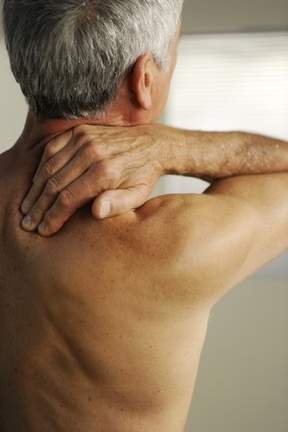Cervical spinal stenosis (spinal stenosis) - Information, diagnosis, and treatment
The narrowing of the spinal canal at the cervical spine leads to symptoms such as neck pain caused by the spinal canal squeezing and compressing the nerve roots where they leave the spinal cord. The symptoms include pain, numbness, and / or paralysis in the arm, but also an unsteady gait, incoordination and changes in the fine sense of touch. The enlargement of the spinal canal must be performed surgically with the goal to restore the spinal cord and the course of the nerve roots.
What causes cervical spinal stenosis?
Similar to the condition at the lumbar spine, a narrowing of the spinal canal at the cervical spine is a result of the normal wear processes, including aging. The intervertebral discs lose their ability to store water, this reduces the height of the intervertebral disc space, relaxes the fibrous ring of the intervertebral disk, and causes a "bulging of the discs" backwards into the spinal canal. The facet joints slide into each other and become unstable, together with the aging process of the disc, this leads to instability of the entire motion segment (a segment movement are two adjacent vertebrae with the intervening intervertebral disc). The body tries to stabilize this instability growing bone. However, this additionally grown bone can also reduce the sectional area of the spinal canal
How is a cervical spinal stenosis diagnosed?
An in-depth physical and neuro-orthopedic examination enable the spine specialist to quickly reach an accurate diagnosis of cervical spinal stenosis. However, in order to exactly estimate the extent of the narrowing it is necessary to perform an MRI. This allows a detailed visualization of the spinal canal with the spinal cord and the on both sides exiting nerve roots without having to take X-rays. The MRI shows all the spinal canal narrowing structures (intervertebral disc, bone and ligaments).
 What are the treatment options for cervical spinal stenosis?
What are the treatment options for cervical spinal stenosis?
The narrowing of the spinal canal at the vertebral canal is often only fully appreciated when it has already come to a damage of the surrounding nerves. Since these symptoms are caused by pressure on the nerve roots and spinal cord, surgery is usually essential in order to prevent worse. A decompression of the cervical spinal canal must be performed.
How is decompression of the cervical spinal canal performed?
Decompressing the cervical spinal canal aims at providing sufficient space to the spinal cord and the nerve roots in order to avoid a worsening of symptoms caused by persistent compression. Simultaneously it allows for pain symptoms to recede. In the KLINIK am RING, decompression is performed under the operating microscope. The surgery is performed in the supine position; access to the cervical spine is possible via a small transverse incision of approximately 3-4 centimeters in length. The respective neck disc is removed under the microscope. The access through the intervertebral disc allows following a gentle removal of all structures that constrict the spinal canal. As a last step, a placeholder made of plastic is placed into the intervertebral disc space.
Much like after the surgery of a cervical herniated disc, part of the after-treatment is a 2-week immobilization of the neck in a soft cervical collar. The duration of stay in the hospital is about three days. A specific post-surgery treatment is not necessary, since the patient will return to daily routine activities soon after the surgery. Sports like swimming, jogging and cycling can be resumed as soon as six weeks after the surgery. All other sports should be discontinued for at least three months following surgery.

